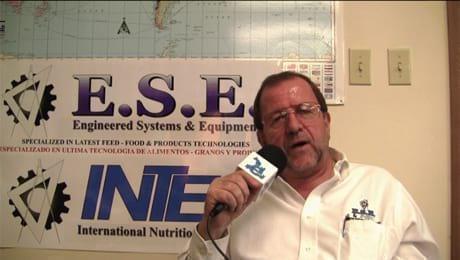Steam boiler capacity for corn flakes
Hello, I have a corn flaking line with 5 to 6 ton/hr capacity steam chest size 13T my steam boiler has the capacity of 3500 kg/hr the boiler is servicing simultaneously a pellet line of 4 ton/hr and the dryer of the flakes is my boiler oversized?
Hello again Mohamad;
For steam calculations, I should say that for each ton of corn being processed you will need 12 BHP (boiler horse power). In your case, 6 TPH x 12 BHP = 72 BHP where 1BHP = 34.5 pounds of steam.
That means the steam chest will need 2,484 pounds of steam per hour to properly hydrolyze the granules of starch in the corn with an average residence time of 45-50 minutes.
The dryer you mention must have steam coils and I want to assume they are properly sized to produce the required BTU/hr to evaporate the moisture in excess in the flaked corn exiting the flaking mill. The boiler you have seems to be a 220 BHP size. If you tell me the amount of BTU/hr the coils produce, I can tell you if the boiler is enough for the pellet mill conditioner, the steam chest and the dryer's coils.
Again; if the steam chest is not properly sized for the required residence time, then the amount of steam will be directly affected.
ED.
Dear Enrique, Mark and friends. After having read carefully and tried to interpret what is exposed here about "BOILER RATING" I have one doubt that I wish to share with all of you and, hope to be able to clarify.
In my old days with the California Pellet Mill Comp. and Ralston Purina. I always used the formula I learned through Mr Reed Macbain (RIP), A CPM Rep. that I have considered (in my old days), the most expertize in the art of Pelletizing, Its formula to calculate the steam requirements in a pelletizing process are very simple and also effective to calculate the capacity of a boiler based on the category of the formulas with the highest capacity of vapor absorption of any feed formula as example I will use “Broiles group”.
It is possible that the process of laminating corn requires more quantity of vapor, but my theory, is directed to the amount of Lbs of steam per hour that would be added to the product once the high pressure steam that comes directly from the boiler reaches the condensation temperature which is 212 ° F since, as it is understood, while the steam is in the boiling state, the product will not be able to absorb moisture.
I am sure that this applies to the process of moistening the corn, except that the maize is given a longer time of retention so that it can absorb moisture and therefore temperature to the core of the grain.
I LIKE TO USE THIS AS AN EXAMPLE AND PLEASE, CLARIFY ME IF IT APPLIES TO THE MAIZE LAMINATION PROCESS.
“BOILER RATING FOR PELLETING A BROILER FEED FORMULA”
At what horsepower should your boiler be rated to provide sufficient steam for particular formulations?
(1) Establish the maximum production rate of the Pellet mill for your easiest running feed.
(2) Convert tons per hour into pounds per hour.
(3) Multiply this figure by the máximum amount of moisture this feed will accept (on broiler feed 6% added for a total of 17 to 18% máximum).
(4) Divide this figure (pound of steam in pound per hour), by 34.5 and them add 15% (15% is what is calculated by possible loss of heat between the boiler and the place where the steam is applied.). This will convert the required volumen of steam in pounds per hour into required boiler horsepower.
EXAMPLE:
Pellet mill running broiler feed at maximum capacity of 12 tons per hour.
2000 X 12 TPH = 24,000 Lbs.
6% of 24.000 = 1,440 Lbs of steam per hour
1440 / 34.5 = 42 HP + 115% X 42 = 47 HP
Good morning Mark.
Thank you very much for your explanation. Your calculations for rolling corn are quite accurate, however, if there is a long residence time of the corn inside the chamber or cooking pot (40 - 60 minutes), in order to obtain humidity, cooking temperature and therefore, gelatinization, something that it is not possible to obtain in the pelletizing process for several reasons that we know and, that precisely different steam pressures and speeds in the conditioner are used to achieve the purposes etc.
From our own experience in corn rolling processes, we have experienced that the time of the product inside the Pot or Chamber for obvious reasons is directly related to the amount of humidity that the grain can absorb since by the nature of the product, as the heat penetrates to the core of the corn kernel, this not only absorbs heat, but also absorbs moisture.
As you know It also happens in the Pelletization process, the greater residence of the product inside the conditioner and the less steam pressure, more humidity and therefore higher temperature you will incorporate in the formulas that you are processing and vice versa.
Mark is a real pleasure to be able to discuss so interesting topics with you since at the same time technical information is shared for the friends that participate in these forums.
My best regards
Mario E Tobar Jaramillo Thank you very much for the information, please share your experience. Take care.
Mario E Tobar Jaramillo
Corn Flake experience
While corn is conveyed to the steam chest they are sprinkled with water
Steam chest takes around 2 hours to reach its maximum level
After 1 hour steam valves are open gradually (4 levels) 12 min between each starting from bottom till top
After 50 min of total steam time flaking starts and the line runs continuously
I got good quality flakes with final moisture 12% (after drying) thickness between 1.8 2.1 mm
I was also able to reduce the boiler oil consumption by 30% when reducing the operating pressure from 8 bar to 6 bars
It would be helpful if you can share your experiences or add your comments
Thanks a lot.
Hey guys, I am glad that you are listening to the GM of many years of San Lorenzo Industry in Puerto Rico. The master in Pelletization and Metallurgists Guru Dr. Mario A.Tobar, In this theme, just listen he can help a lot, that why in PR, Colombia and around the world was very busy teaching seminars of this king of knowledge! Proud of his invention and Mastering in the first self computerized Soybean Toaster. And no doubt he still loves to help with the same passion like in the old days .... thanks for being my father and proud of you for helping the future generations with your knowledge!















.jpg&w=3840&q=75)